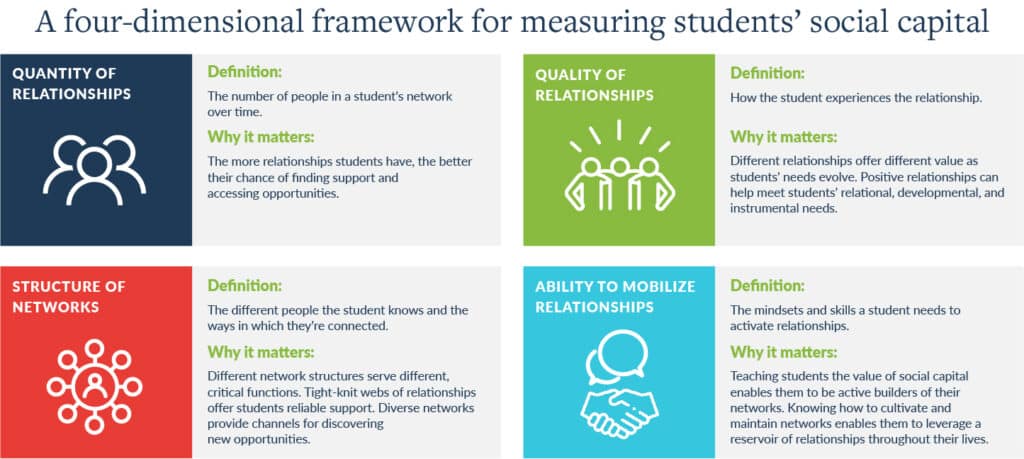In the midst of the COVID-19 pandemic, Colby College turned heads in May when it guaranteed that all 300 of its seniors still in search of work would have a meaningful opportunity within three months of graduating.
When asked how it would accomplish this, Colby’s president, David Greene, told CNBC, “We need 300 jobs, but we have 30,000 alums and family members… who are ready to help.”
That a jobs guarantee is newsworthy says a lot about higher education today. President Greene calling on Colby alumni and families reflects the fact that it’s networks—not just degrees—that lead to jobs.
The move also suggests that networks shouldn’t just be summoned as part of a noble triage effort for graduates in dire straights. Helping students build supportive and widespread networks should be an ongoing part of how colleges design and measure the student experience.
Brokering networks of support and opportunity
Even before hitting the job market, the social aspects of college life—access to peer networks, holistic student supports, and strong faculty relationships—are all key components to ensure students graduate. And relationships, particularly with faculty, are also key channels to work experiences and internships during school that serve as on-ramps to good first jobs.
Yet colleges aren’t all that good at building and mobilizing students’ networks in a reliable, much less equitable, manner. In fact, according to the 2018 Strada-Gallup Alumni survey, fewer than half of alums reported that while attending their institution they had access to a mentor who encouraged them to pursue their goals and dreams. Of those alums who did report access to a mentor, 72% of white graduates said their mentor was a professor, whereas only 47% of non-white graduates said the same.
In response, innovative programs are emerging to ensure that access to networks isn’t left to chance, particularly for historically underrepresented students.
Some are working to ensure that students have access to supportive relationships from day one on campus.
For example, Beyond 12 partners with colleges to offer virtual one-on-one coaching to low-income, first-generation, and historically underrepresented students to support them through college. The model hinges on what Beyond 12’s founder and CEO Alex Bernadotte calls a “high-tech, high-touch solution”—a college success curriculum delivered by virtual, near-peer coaches and supported by a digital app and backend analytics.
Beyond 12’s coaches also help students connect with peers, faculty, and support networks on campus. In the course of the curriculum, students engage in activities to identify their existing networks and reflect on how those close connections and casual acquaintances might help them accomplish their goals.
Other programs help expand students’ access to professional networks.
Braven partners with universities to offer a course for low-income and first-generation students and students of color aimed at empowering them with the skills, confidence, experience, and networks necessary to transition from college to strong first jobs. Braven is now attempting to reach even more students with a short, intensive, virtual program, called Booster, to reach low-income and first-generation graduating seniors and recent alums who are navigating their job search during the pandemic and recession.
Missing metrics in the student success equation
Making sure students are developing their networks is complex. But measuring students’ connections can help colleges make sense of that complexity and provide more students with personalized support and mentorship.
As the saying goes, you measure what you treasure. Given the importance of networks for graduating and securing a good first job, colleges should care about students’ networks.
Organizations like Beyond 12 and Braven aren’t just connecting students to relationships. They are also measuring how well connected their students are.
At Beyond 12, coaches work with students to map out their own networks and identify how various relationships could help them to accomplish their goals. They also log students’ progress toward building on-campus connections by tracking indicators such as identifying a campus mentor, finding at least three peers who can serve as references, and creating at least one study group with high-performing peers.
Braven keeps careful tabs on whether students are successfully growing their networks.
“Since social capital is such an important component of our theory of change, we’ve taken a multifaceted approach to measuring Fellows’ social capital,” Aimee Eubanks Davis, Braven’s founder and CEO, said. “Our strategies have included measuring the strength of Fellows friendship networks, advice networks, and sense of social and academic fit within their university before and after completing Braven. We also look at the number of professionals Fellows report meeting through the program, their relationship with their Leadership Coach, and the number of LinkedIn connections they have.”
Beyond 12 and Braven are just two examples among a growing movement to begin measuring students’ support structures and professional networks. The Christensen Institute’s recent report, The missing metrics: Emerging practices for measuring students’ relationships and networks, that Julia Freeland Fisher authored with Mahnaz Charania, offers a structure to measure networks across multiple dimensions, by capturing the quantity and quality of relationships in students’ networks, the structure of students’ networks, and students’ ability to build and mobilize networks post-graduation. Together these measures offer a more complete picture of if and to what extent institutions are successfully building their students’ networks.

Students need access to the right resources to navigate uncertain times. Connections—to peers, faculty, and alumni networks—are an asset that colleges are quick to advertise and, when in a bind like Colby, mobilize. It’s time colleges start measuring them, too.




